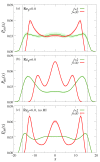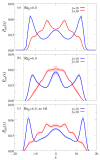Flow Behavior of Chain and Star Polymers and Their Mixtures
- PMID: 30966633
- PMCID: PMC6403976
- DOI: 10.3390/polym10060599
Flow Behavior of Chain and Star Polymers and Their Mixtures
Abstract
Star-shaped polymers show a continuous change of properties from flexible linear chains to soft colloids, as the number of arms is increased. To investigate the effect of macromolecular architecture on the flow properties, we employ computer simulations of single chain and star polymers as well as of their mixtures under Poiseuille flow. Hydrodynamic interactions are incorporated through the multi-particle collision dynamics (MPCD) technique, while a bead-spring model is used to describe the polymers. For the ultradilute systems at rest, the polymers are distributed uniformly in the slit channel, with a weak dependence on their number of arms. Once flow is applied, however, we find that the stars migrate much more strongly towards the channel center as the number of arms is increased. In the star-chain mixtures, we find a flow-induced separation between stars and chains, with the stars located in the channel center and the chains closer to the walls. In order to identify the origin of this flow-induced partitioning, we conduct additional simulations without hydrodynamic interactions, and find that the observed cross-stream migration originates from a combination of wall-induced hydrodynamic lift forces and viscoelastic effects. The results from our study give valuable insights for designing microfluidic devices for separating polymers based on their architecture.
Keywords: Poiseuille flow; chains; microfluidics; polymers; separation; simulations; stars.
Conflict of interest statement
The authors declare no conflict of interest. The founding sponsors had no role in the design of the study; in the collection, analyses, or interpretation of data; in the writing of the manuscript, and in the decision to publish the results.
Figures







References
-
- Squires T.M., Quake S.R. Microfluidics: Fluid physics at the nanoliter scale. Rev. Mod. Phys. 2005;77:977. doi: 10.1103/RevModPhys.77.977. - DOI
-
- Chen X., Cui D.F., Liu C.C., Li H. Microfluidic chip for blood cell separation and collection based on crossflow filtration. Sens. Actuators B Chem. 2008;130:216–221. doi: 10.1016/j.snb.2007.07.126. - DOI
Grants and funding
LinkOut - more resources
Full Text Sources

